Silky steamed eggplant meets the gentle umami of shio koji in these vegan gunkan sushi. A quiet summer kitchen creation, adaptable as shojin-style vegetable sushi. Wrap in shiso leaves for fragrant temari sushi.
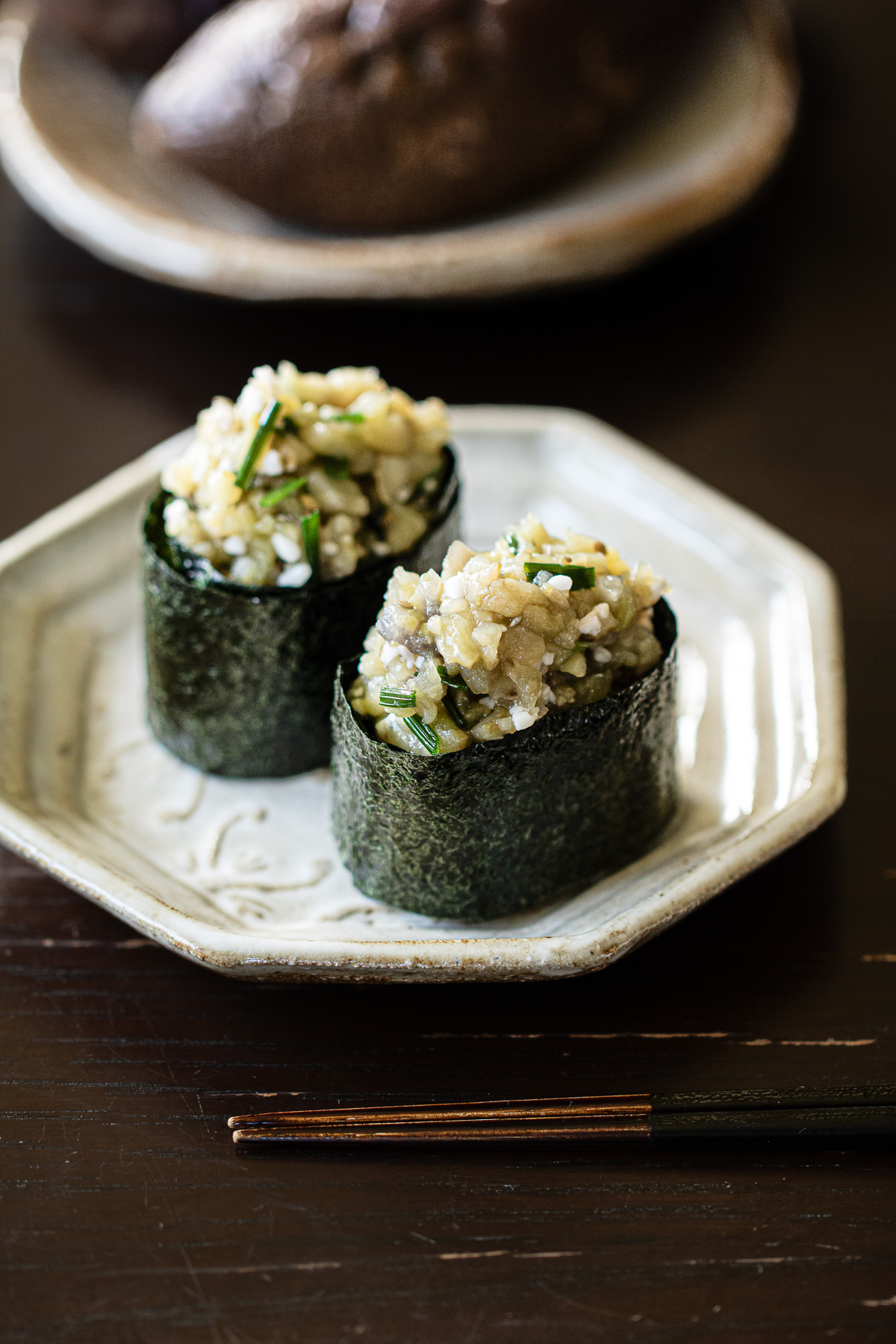
Prep Time: 15 minutes | Cook Time: 15 minutes | Total Time: 30 minutes
Servings: 8-10 pieces | Cuisine: Japanese | Diet: Vegan, Plant-Based
Jump to:
🍁 From My Autumn Kitchen
This summer, I put away my frying pan.
My steamer, forgotten in the cupboard for months, became a daily companion. I filled it with eggplants—glossy purple ones from the market, their skin tight and cool to the touch.
Fifteen minutes of steam, and they transform. The flesh turns translucent, almost custard-like. When I peel away the skin with my knife, it comes away clean, revealing that silky interior.
That's when this sushi was born—Steamed Eggplant Gunkan with Shio Koji.
I chop the eggplant until it becomes almost a paste, fold in the shio koji and sesame oil. The scent rises—nutty, fermented, somehow both sharp and mellow. A few green scallions for color.
When I steam extra eggplant, I dress it simply with umeboshi paste and more sesame oil (Steamed eggplant umeboshi marinade). Two dishes from one steaming. The quiet efficiency of it pleases me.
Steamed eggplant is nothing like grilled. No char, no smoke—just pure sweetness and that texture that melts on the tongue. I've watched plates empty in silence, even from those who claim not to like eggplant.
On evenings when appetite fails, when the heat presses down, these little boats of rice and eggplant go down easily.
Gentle food for the turning season.

🧺 What This Recipe Brings
- Vegan sushi without imitation or compromise
- Autumn eggplant and shio koji—umami drawn out through fermentation
- Shojin sushi when you omit the scallions
- Quiet enough for one, beautiful enough for guests
- A meditation in steaming and shaping
🍙 What You'll Need
For the Eggplant
- 2-300g Japanese eggplants (or any variety with few seeds—white eggplant is lovely if you find it)
- 1~2 teaspoons shio koji (salted rice koji)- This fermented ingredient adds incredible umami depth. Find it at Japanese grocery stores or make your own.
- ½ teaspoon toasted sesame oil
- Finely chopped scallions (wakegi or green onions—omit for shojin style), to taste
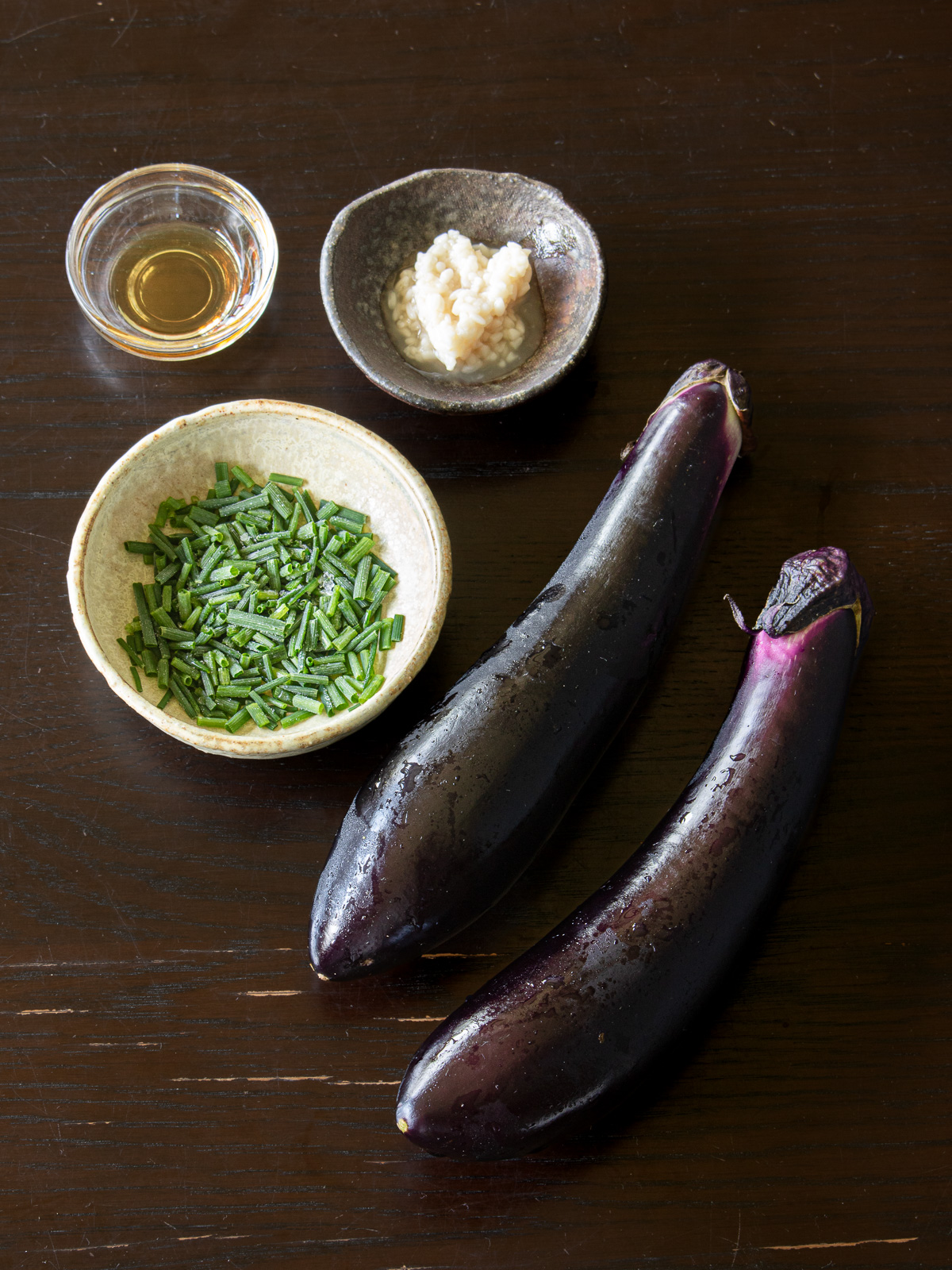
For the Sushi
- ¾ cups cooked short-grain rice (about 160g)
- 2 sheets nori seaweed, cut into strips
- Water for moistening hands
What You'll Use
- Steamer (bamboo or metal)
- Sharp knife
- Mixing bowl
- Kitchen scissors
- Small bowl of water
🥣 How to Make
The work happens in two parts: first the eggplant, then the shaping.
Step 1: Steam the Eggplant (10-15 minutes)
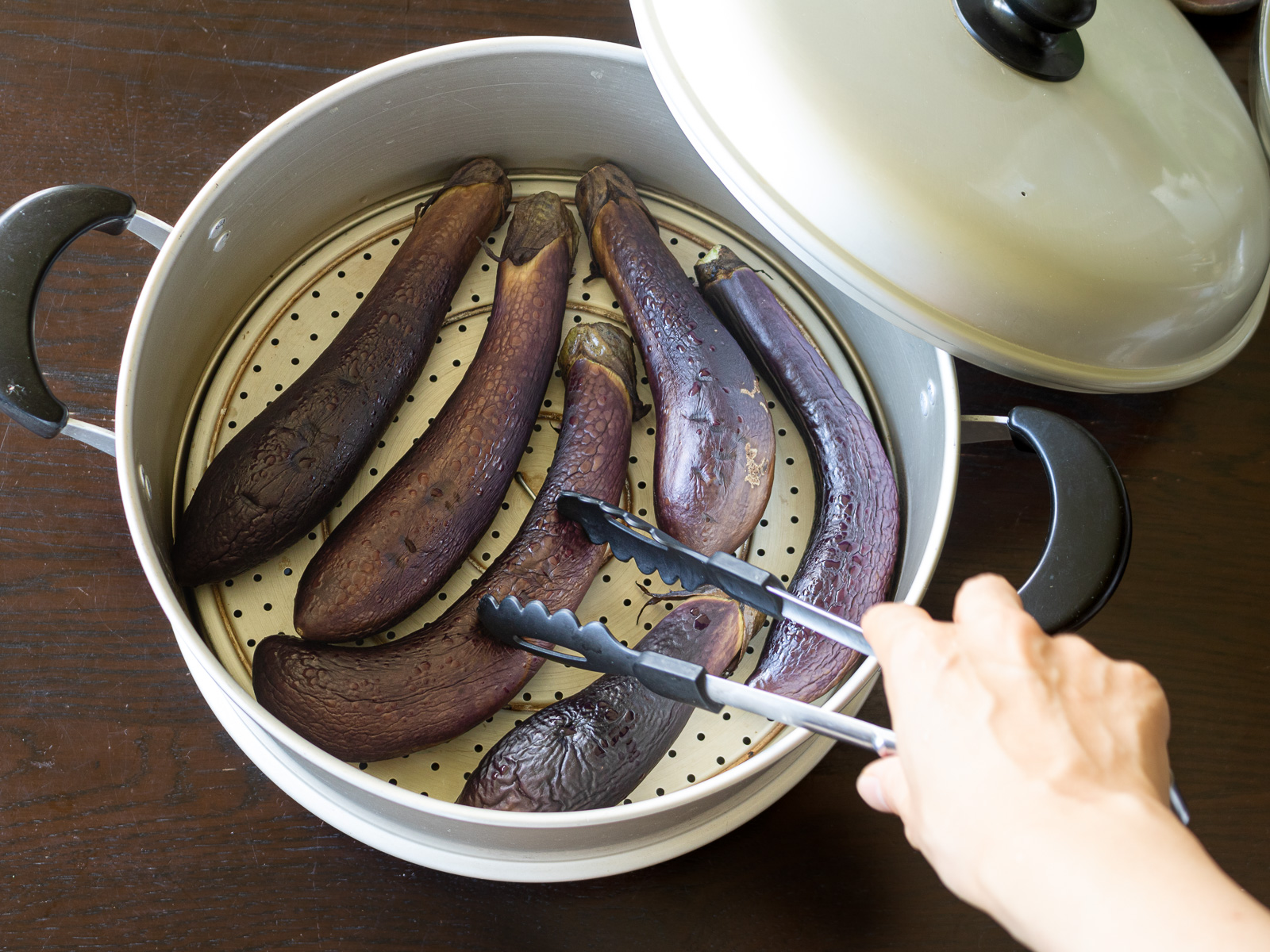
- Steam
- Bring water to boil in your steamer.
- Place whole, unpeeled eggplants in the basket. Cover.
- Let the steam work for 10-15 minutes, until the eggplants yield completely when pressed—no resistance, just soft give.
🌿 Timing guide:The time depends on thickness. Thin Japanese eggplants finish quickly; plumper varieties take longer. You'll know by feel.
🌿 Kitchen wisdom: If your steamer has space, add other vegetables—potatoes, kabocha, sweet potatoes. Make use of the heat.

- Peel
- Let them cool just enough to handle—still warm, but not burning.
- The skin peels away easily now, coming off in long strips under your knife.
🌿 If skin resists: Eggplant needs more cooling time, or wasn't steamed long enough.
🌿 What to do with skins: Compost them, or save for vegetable stock if you make it.
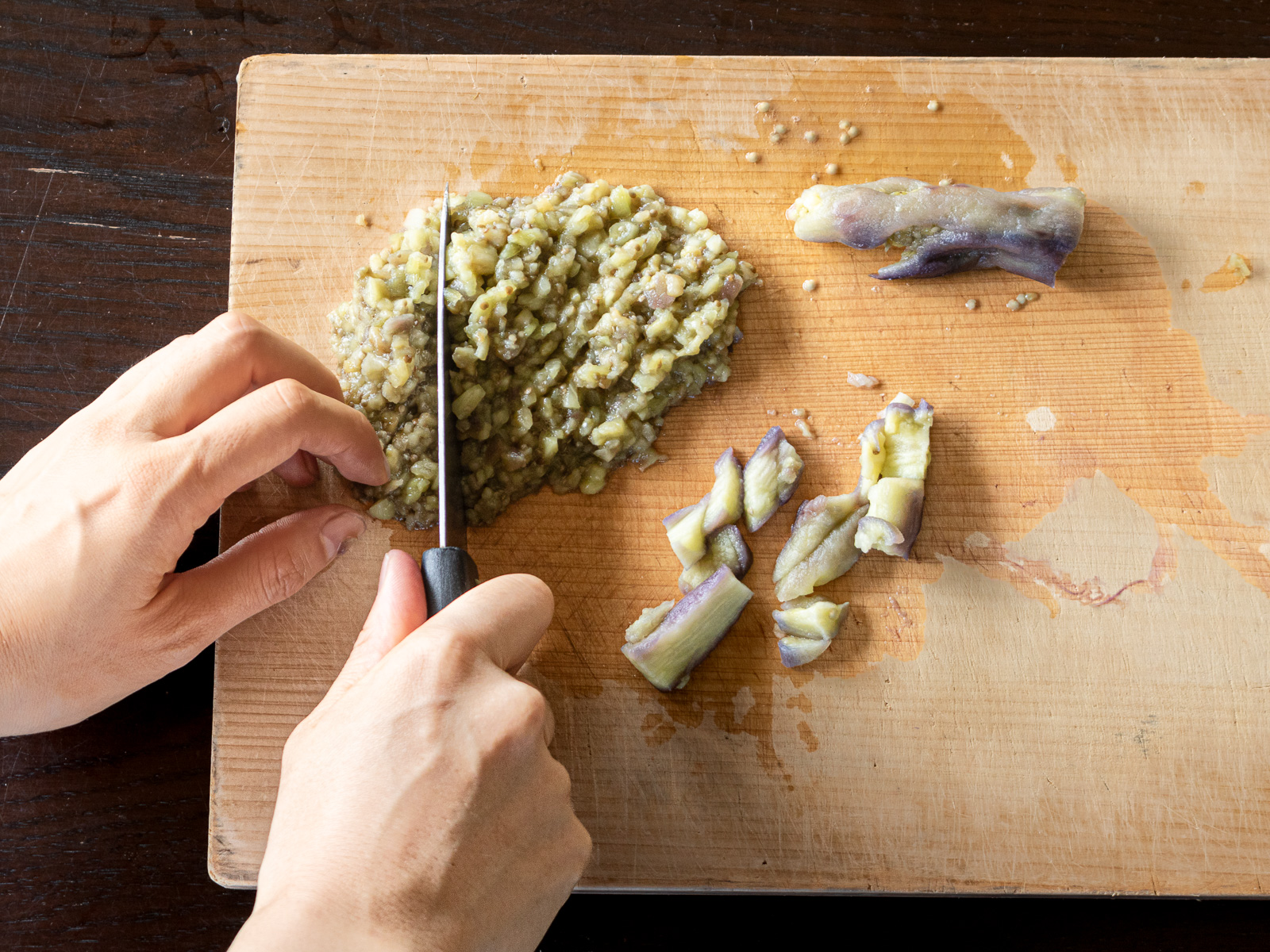
- Chop
- Measure out 200g (about 7 oz) of the steamed eggplant flesh—this is roughly what 2-3 medium eggplants yield after peeling. Save any extra for another dish.
- On your cutting board, work the knife through the eggplant, chopping finely until it becomes almost paste-like.
- Rough is fine—this isn't precision work.
🌿 If you see many large seeds: Use a spoon to scrape them out before chopping. They can add bitterness.
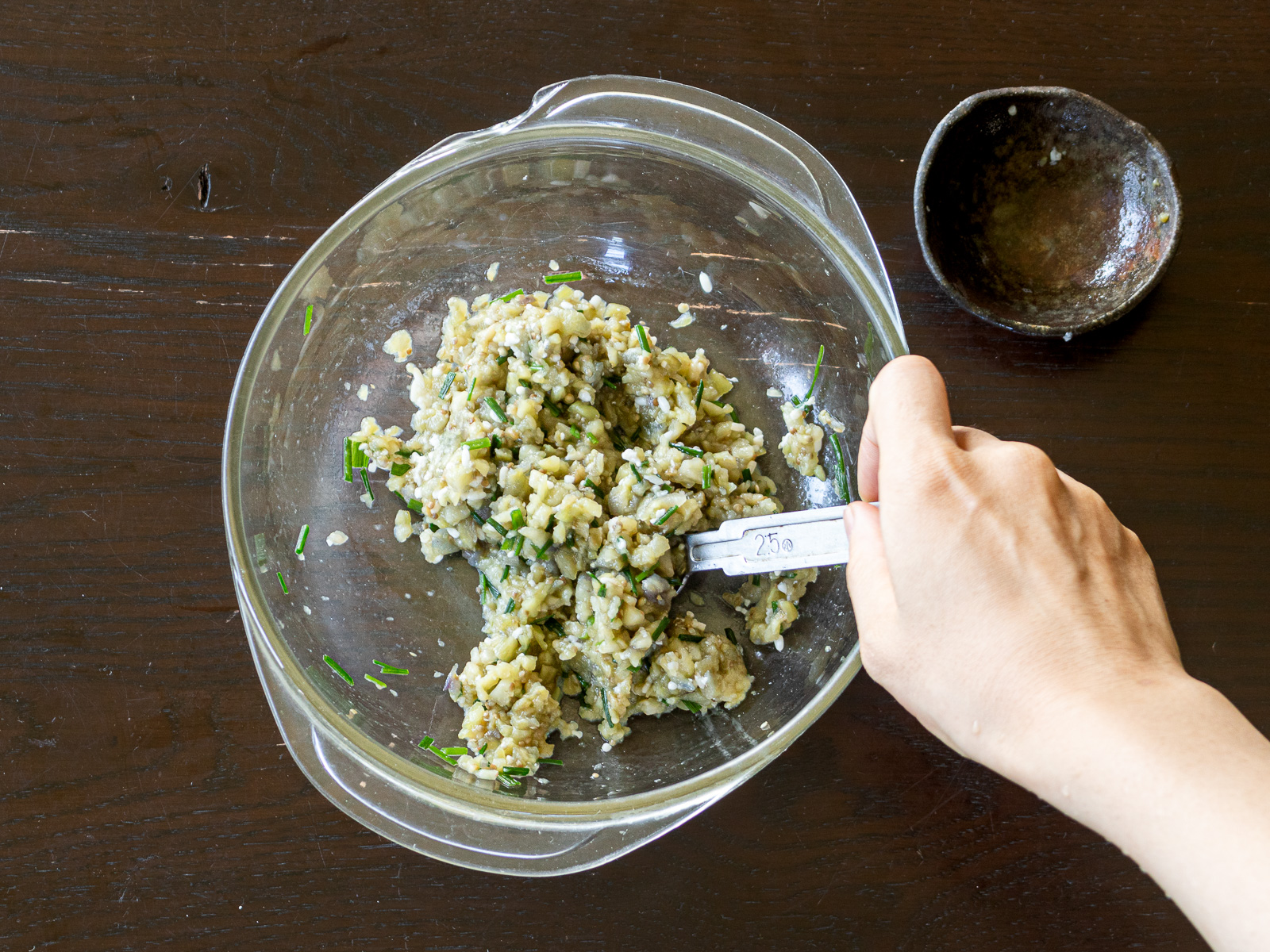
- Season
- In a bowl, combine:
- 200g (7 oz) chopped eggplant
- 1~2 teaspoons shio koji
- ½ teaspoon sesame oil
- Chopped scallions (or omit)
- Mix until everything glistens.
- Taste. Adjust if needed—though the koji usually provides enough salt.
- In a bowl, combine:
Part 2: Shaping the Sushi
Before You Begin: Set Up Your Station
This makes the work flow smoothly:
- Small bowl of water (for wetting hands)
- The eggplant mixture in a bowl
- Pre-cut nori strips arranged nearby
- Rice, slightly cooled, within reach
- Clean, dry workspace
🌿 Kitchen wisdom: Sushi making is about rhythm. Once you start, you want everything at hand.

- Shape the rice
- Wet your hands lightly—just enough to prevent sticking, not so much that the rice becomes soggy.
- Take about 20g of rice (roughly a heaping tablespoon).
- Shape it gently into an oval, pressing just enough to hold form. Don't compress too much. Rice needs air.
🌿 If using leftover rice from the refrigerator, warm it briefly—10 seconds in the microwave. Cold rice won't shape.

- Cut the Nori Strips
- Use kitchen scissors to cut nori sheets into strips. Standard sushi nori has perforated lines—cut along these for strips about 1-1.5 inches (3-4 cm) wide.
- Each strip should be long enough to wrap around your rice ball—usually 6-7 inches (15-18 cm).
🌿 Cut all strips before assembling—it streamlines the process
🌿 Keep nori sealed in container until ready to use—humidity softens it quickly
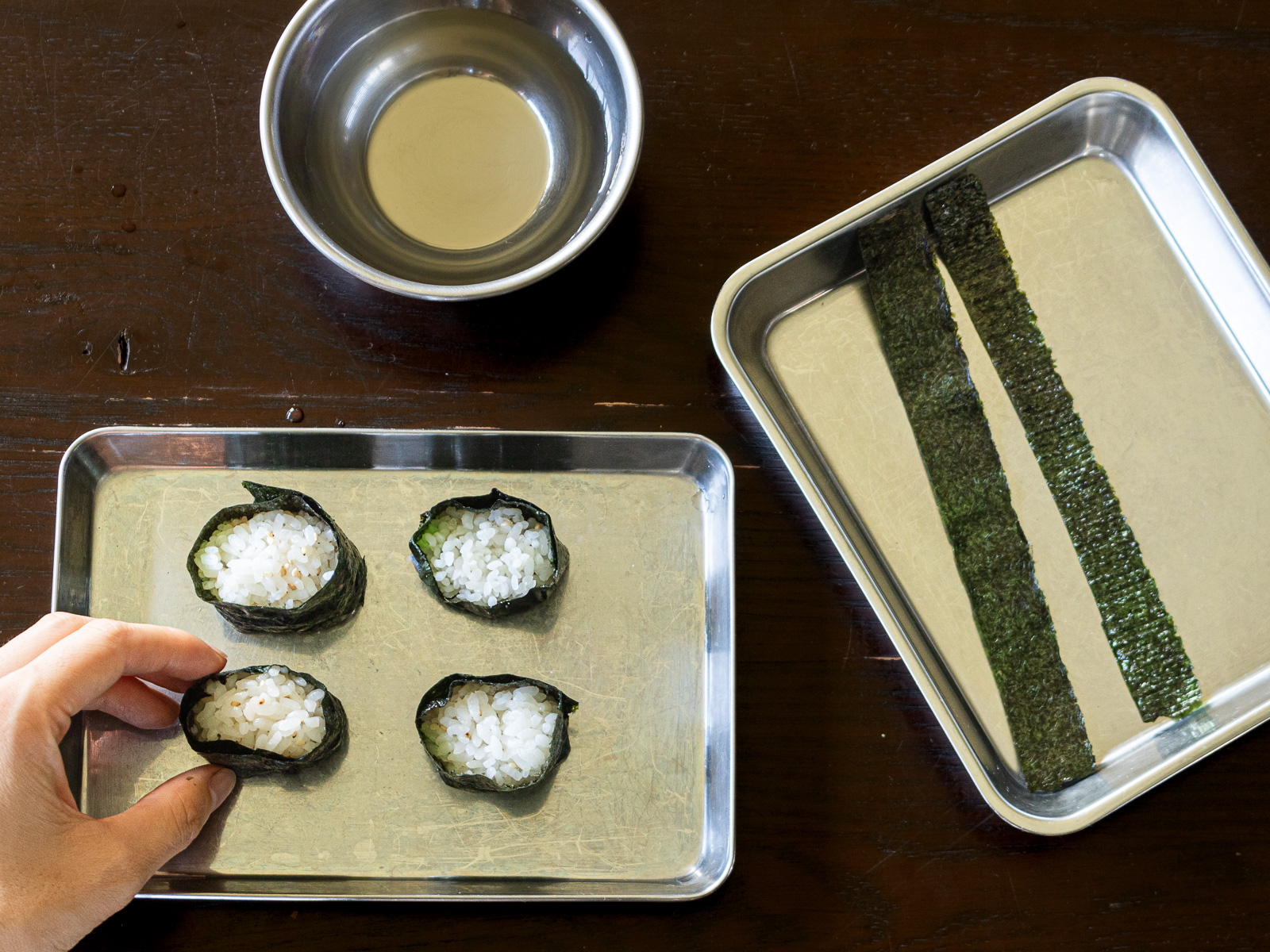
- Wrap with nori
- Take a strip of nori and wrap it around the sides of your rice oval, shiny side out. The nori should rise slightly above the rice, creating a small cup to hold the topping.
- Press gently where the ends overlap. If the nori won't stick, use a crushed grain of rice as glue.
🌿 In humid weather, wrap twice—the moisture from the eggplant can soften nori quickly.
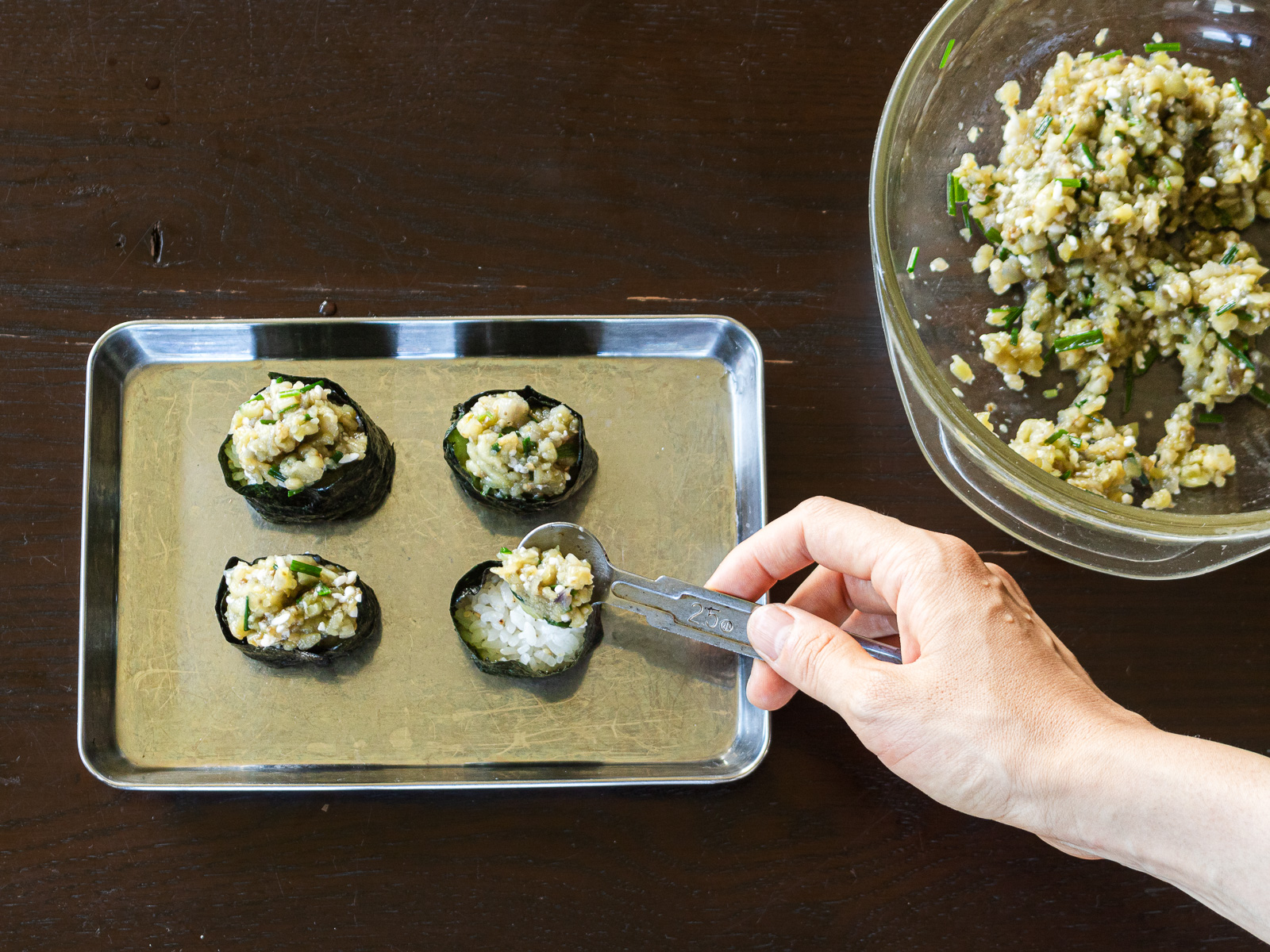
- Add the topping
- Spoon the eggplant mixture generously into the nori cup. Don't be shy—the abundant topping is part of gunkan's charm.
- Serve immediately, while the nori still has its crispness.
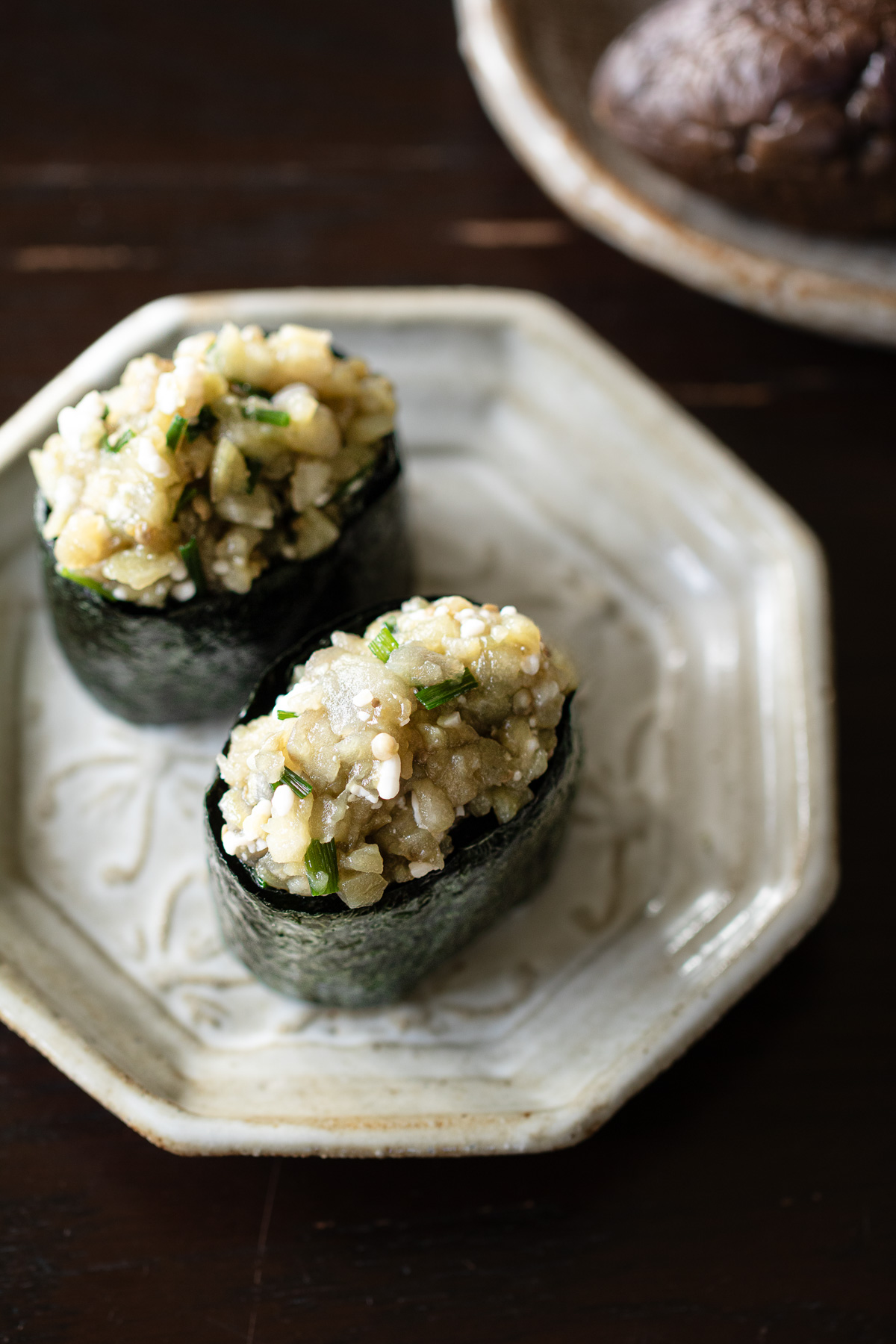
📚 Tips
▶︎ For shojin (Buddhist vegetarian) style
Omit the scallions—they're one of the five pungent vegetables avoided in temple cuisine. Instead, try:
- Thin slices of myoga (Japanese ginger)
- Shredded fresh ginger
- Julienned shiso leaves
- Toasted sesame seeds
▶︎ If using leftover rice
Warm it gently first. Cold rice from the refrigerator is difficult to shape and unpleasant to eat in sushi. A few seconds of heat makes all the difference.
▶︎ When nori softens too quickly
This happens in summer, or when the topping is very moist. Two solutions: wrap the nori in two layers, or make and eat immediately. Sushi with moist toppings doesn't wait.
▶︎ When eggplant mixture is too watery
- Let steamed eggplant cool and drain in a colander for 5 minutes before chopping
- Gently squeeze out excess moisture with paper towels after chopping
- Some eggplant varieties are naturally more watery—it happens
▶︎ On the eggplant texture
The steaming method produces a different result than grilling. No smokiness, but a pure, clean sweetness. The flesh becomes almost creamy. If you prefer a denser texture, try roasting instead (see variations below).
📘 Kitchen Notes|Wisdom & Variations
✿ Choosing Your Eggplant
➤Japanese eggplant (nasu): Long, slender, deep purple. Tender skin, few seeds, sweet flavor. My first choice if available.
➤White eggplant: Creamy flesh, mild flavor, fewer seeds. Beautiful if you find it. Roasting works especially well with this variety.
➤Italian/globe eggplant: Most common in Western markets. Choose smaller, younger ones with glossy, tight skin—they have fewer seeds and less bitterness.
➤What to avoid: Large, mature eggplants with dull skin and soft spots. These have more seeds and can taste bitter.
✿ About Shio Koji
This fermented rice seasoning is central to the dish. It brings:
- Natural umami (like aged cheese or miso)
- Enzymes that tenderize and enhance sweetness
- Probiotics for gut health
- Subtle complexity you can't get from plain salt
Where to find it: Japanese grocery stores (refrigerated section), online retailers, or make your own (it's just rice koji, salt, and water fermented for a week).
How to store it: Refrigerated, it keeps for 6 months or more.
✿ Temari-Style with Shiso (Hand-Wrapped)
For a more casual, interactive way to eat:
Place large green shiso leaves on a plate. Shape rice into small balls, arrange them on the leaves. Top each rice ball with a generous amount of the eggplant mixture—go ahead and pile it on if you like.
To eat: pick up a rice ball with the shiso leaf underneath, wrap the leaf around it as you bring it to your mouth. The shiso acts as both wrapper and aromatic—your hands stay clean, and each bite is fragrant with that bright, herbal scent. A few slices of homemade pickled ginger alongside completes the picture.
It's a playful way to serve these. Everyone wraps their own, using their hands, no chopsticks needed. The kind of food that makes people lean in and focus on the act of eating.

✿ With Roasted White Eggplant
For a deeper, more concentrated flavor:
- Cut white eggplant into thick wedges (about 2 inches).
- Brush lightly with vegetable oil.
- Arrange on parchment paper.
- Roast at 450°F (230°C) for 15 minutes, turn, then 10 minutes more.
The flesh will be golden at the edges, collapsed and tender. Peel and chop as you would steamed eggplant.
This version has less moisture, more intensity. Almost melts on the tongue.
✿ Sesame Rice Base
Before shaping, fold into the warm rice:
- 1 teaspoon ~ toasted sesame seeds
- Dash of sesame oil
- Small pinch of salt
This makes the rice itself more flavorful, substantial enough to eat on its own.
🍽️ Serving Thoughts
I serve these on a simple wooden board, or individual small plates if guests are coming. Alongside:
- Pickled ginger ( check 👉How to make homemade Beni-shoga)
- A small dish of soy sauce (though they don't need it)
- Hot green tea
For a fuller meal, add Hearty Vegetable Shiokoji Miso Soup and a cucumber sunomono salad. Maybe some steamed edamame, still warm, dusted with salt.
The sushi should be room temperature—not cold from the refrigerator. The rice texture suffers from cold.
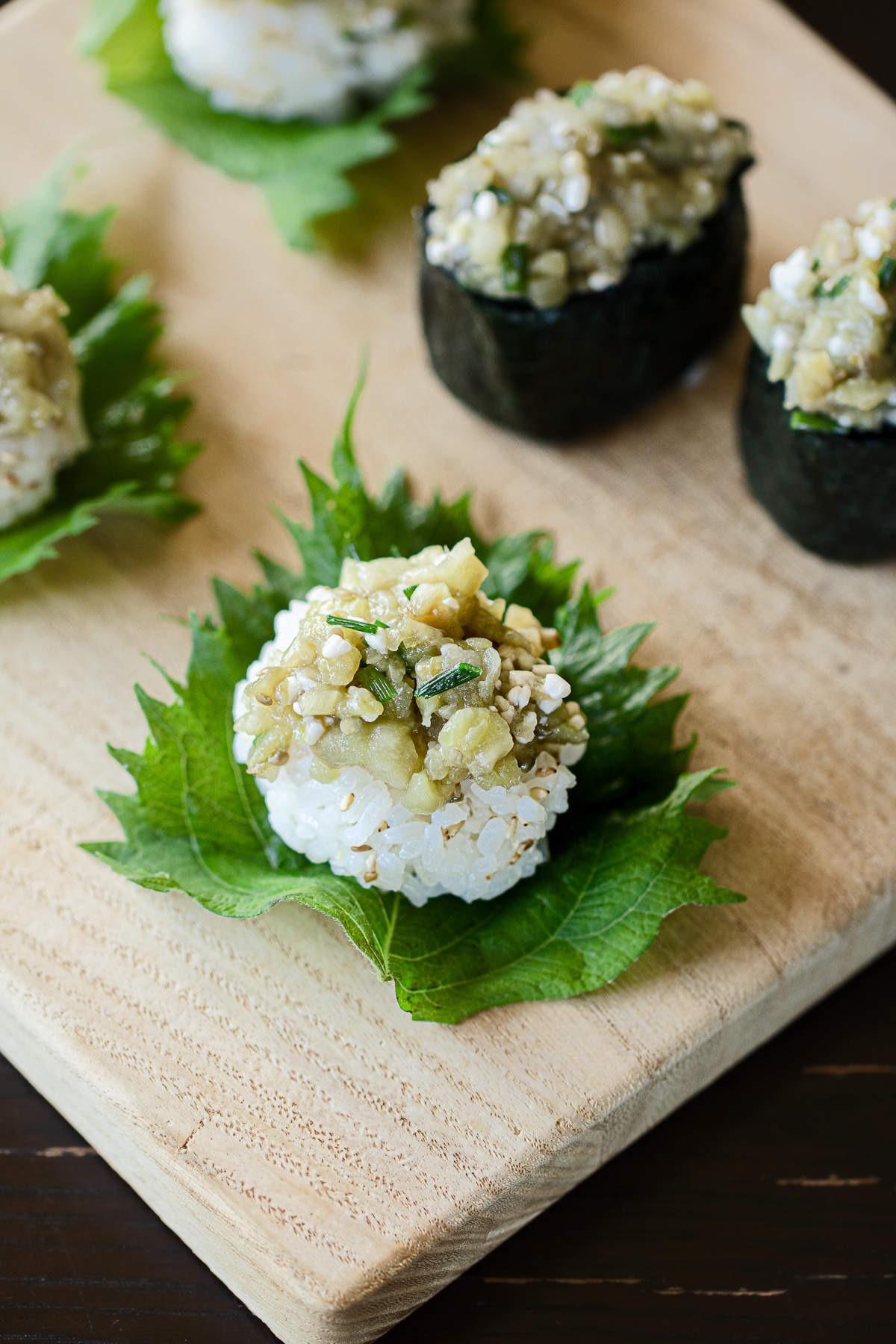
🫙 Keeping & Storing
➤The eggplant mixture keeps for a day, covered, in the refrigerator. Longer than that and it begins to weep liquid, loses its fresh taste.
➤The assembled sushi should be eaten within an hour or two. The nori softens, the rice dries. They're at their best immediately.
➤Components separately: If you must prepare ahead, keep everything separate—rice at room temperature (covered), eggplant mixture chilled, nori sealed away from moisture. Assemble just before serving.
I don't recommend freezing any part of this. Rice texture doesn't survive it.
🍵 On Gunkan Sushi & Shojin Cuisine
Gunkan means "battleship"—the nori wrapped around rice resembles a boat. Traditional gunkan holds loose toppings like salmon roe or sea urchin. The nori acts as both structure and vessel.
This vegan version follows the same principle, but draws from shojin ryori, the temple cuisine of Zen Buddhist monks. Shojin cooking avoids:
- All animal products
- The five pungent vegetables (onions, garlic, leeks, chives, scallions)
- Waste and excess
It emphasizes:
- Seasonal ingredients
- Five colors, five flavors, five cooking methods
- Mindful preparation
- Gratitude for each ingredient's journey
When you omit the scallions from this recipe, it aligns with shojin principles. The eggplant itself becomes the star—no need for strong aromatics to mask or enhance.
There's a quietness to shojin food. An absence of shouting flavors. Everything in its place, nothing excess.
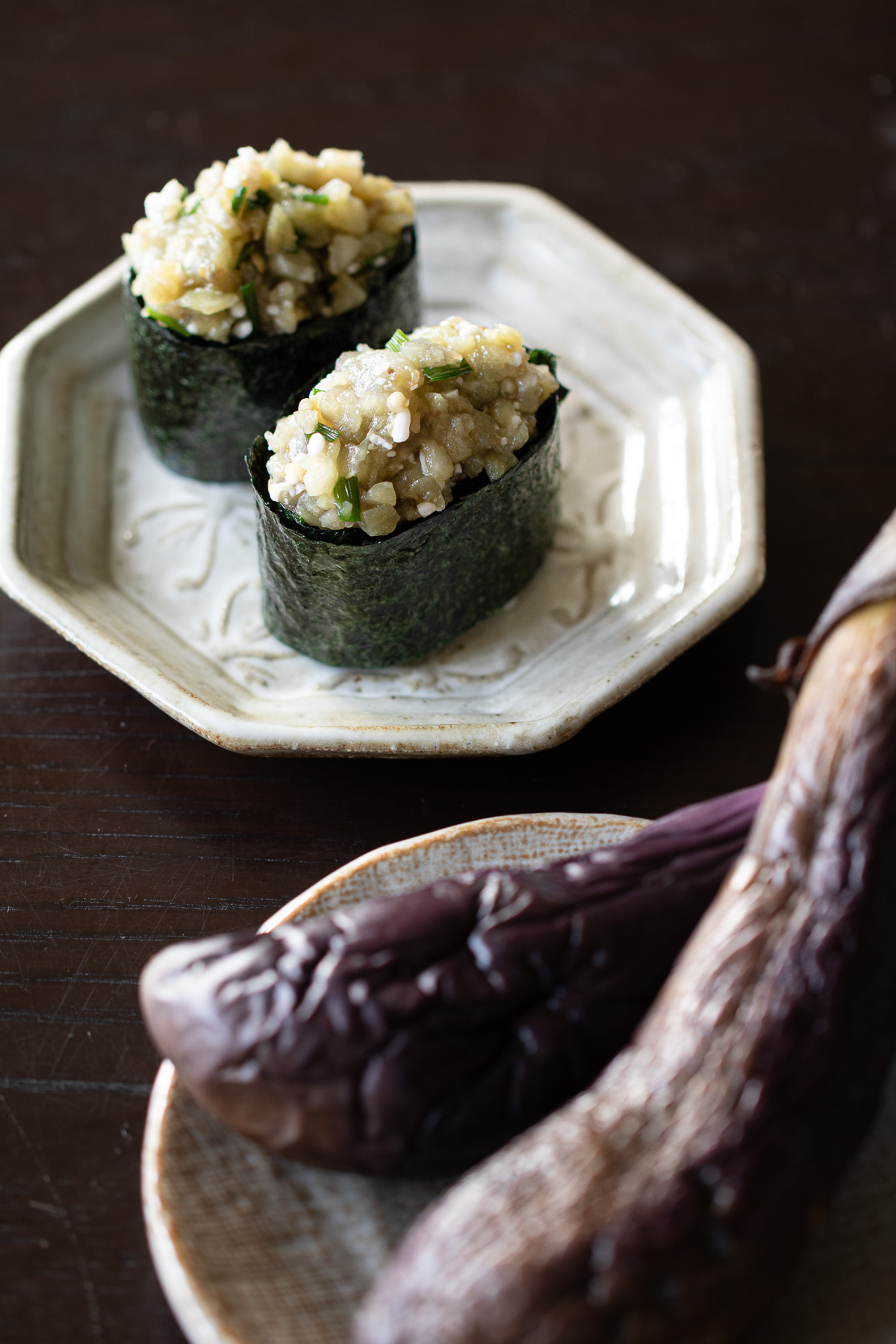
💭 FAQ
No—gunkan is actually easier than most sushi. The nori holds everything together, so you don't need to master nigiri's hand-shaping or maki's rolling technique. If you can shape rice into an oval and wrap nori around it, you can make this.
Yes. Choose smaller, younger ones with tighter skin and fewer seeds. The seeds can be bitter, though removing them helps.
Japanese grocery stores, in the refrigerated section. Or online. If you can't find it, substitute with white miso paste thinned slightly with water. Or use a combination of soy sauce and a tiny pinch of sugar for umami. The flavor will differ but still be delicious.
You can, though the texture differs. Microwaving tends to make eggplant rubbery in spots. Steaming is gentler, more even. But if convenience matters more, microwave on high for 5-6 minutes, checking for softness.
Too cold, or not enough moisture on your hands. Rice needs to be room temperature or slightly warm to be pliable. And keep that bowl of water nearby—dip your fingertips often.
Yes. Let them shape the rice balls, wrap the nori, add the topping. The steaming and knife work you can handle. It's a good recipe for small hands—forgiving, and satisfying to see the results stack up.
Use a metal colander set over a pot of boiling water, covered with a lid. Or roast the eggplants whole in a 400°F oven until completely collapsed—about 30 minutes.
🥢 Other Ways with Eggplant
If you find yourself with more steamed eggplant than you need for sushi:
➤Dressed with umeboshi paste and sesame oil — Chop roughly, mix with a spoonful of umeboshi paste (or a few chopped umeboshi plums), sesame oil, and a sprinkle of sesame seeds. Serve cold or room temperature.
➤Miso dengaku — Slice steamed eggplant in half lengthwise, brush with sweetened miso paste (miso mixed with mirin and a touch of sugar), and broil until the top caramelizes.
➤Cold eggplant salad — Tear into strips, toss with rice vinegar, soy sauce, grated ginger, and scallions. Chill and serve as a side dish.
The steaming technique itself is versatile—use it for kabocha, sweet potatoes, daikon, any vegetable that benefits from gentle, moist heat.
More vegan eggplant recipes are here:
🌾 More Rice Dishes to Explore
Once you have sushi rice prepared, consider:
- Inari sushi (rice tucked into sweet fried tofu pockets)
- Onigiri with various fillings
- Scattered sushi (chirashi) with seasonal vegetables
- Rice bowls with miso-glazed vegetables
The fundamentals are the same—good rice, careful seasoning, simple toppings. Sushi is less about complexity and more about respect for each ingredient.
📖 Recipe Summary|Printable
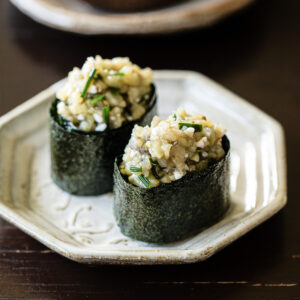
Vegan Eggplant Gunkan Sushi with Shio Koji
Equipment
- steamer (bamboo or metal basket)
- Sharp knife
- Kitchen scissors
- Small bowl of water
- Mixing bowl
Ingredients
- 2-3 Japanese eggplants (to yield 200g / 7 oz steamed flesh)
- 1~2 teaspoon shio koji
- ½ teaspoon toasted sesame oil
- chopped scallions (to taste, optional for shojin style)
- ¾ cups cooked short-grain rice (160g)
- 2 nori sheets (cut into 1-inch strips)
Instructions
Eggplant:
- Steam whole eggplants 10-15 minutes until completely soft2-3 Japanese eggplants
- Cool 5 minutes, peel off skin
- Measure 200g (7 oz) of the flesh and chop finely into rough paste
- Mix with shio koji, sesame oil, scallions1~2 teaspoon shio koji½ teaspoon toasted sesame oilchopped scallions
Sushi:
- Wet hands, shape 20g rice portions into ovals¾ cups cooked short-grain rice
- Wrap each with nori strip (shiny side out, extending above rice)2 nori sheets
- Fill nori cups generously with eggplant mixture
- Serve immediately
Notes
- For shojin (Buddhist vegetarian): omit scallions, add shiso/ginger/sesame instead
- Substitute koji with: white miso (1 teaspoon + ½ teaspoon water) OR soy sauce (1 teaspoon + pinch sugar)
- Roasted eggplant variation: 450°F for 15 min, flip, 10 min more
- Best eaten within 1 hour—nori softens quickly
- Components keep separately (eggplant mixture 24 hours refrigerated)
🗻 In Closing
This recipe came from a summer of simplicity—a season of putting down the oil pan and picking up the steamer lid. Of watching vegetables transform through nothing but heat and moisture.
Gunkan sushi asks so little: good rice, fresh vegetables, clean flavors. The nori holds everything together, literally and figuratively.
The eggplant, steamed until it nearly dissolves, seasoned with the gentle funk of koji, tucked into its little boat of rice—it's complete. Nothing more needed.
Make this when the eggplants are glossy at the market, when you want something beautiful but light, when you need food that nourishes without demanding much.
The work is quiet. The result speaks softly.
That's enough.
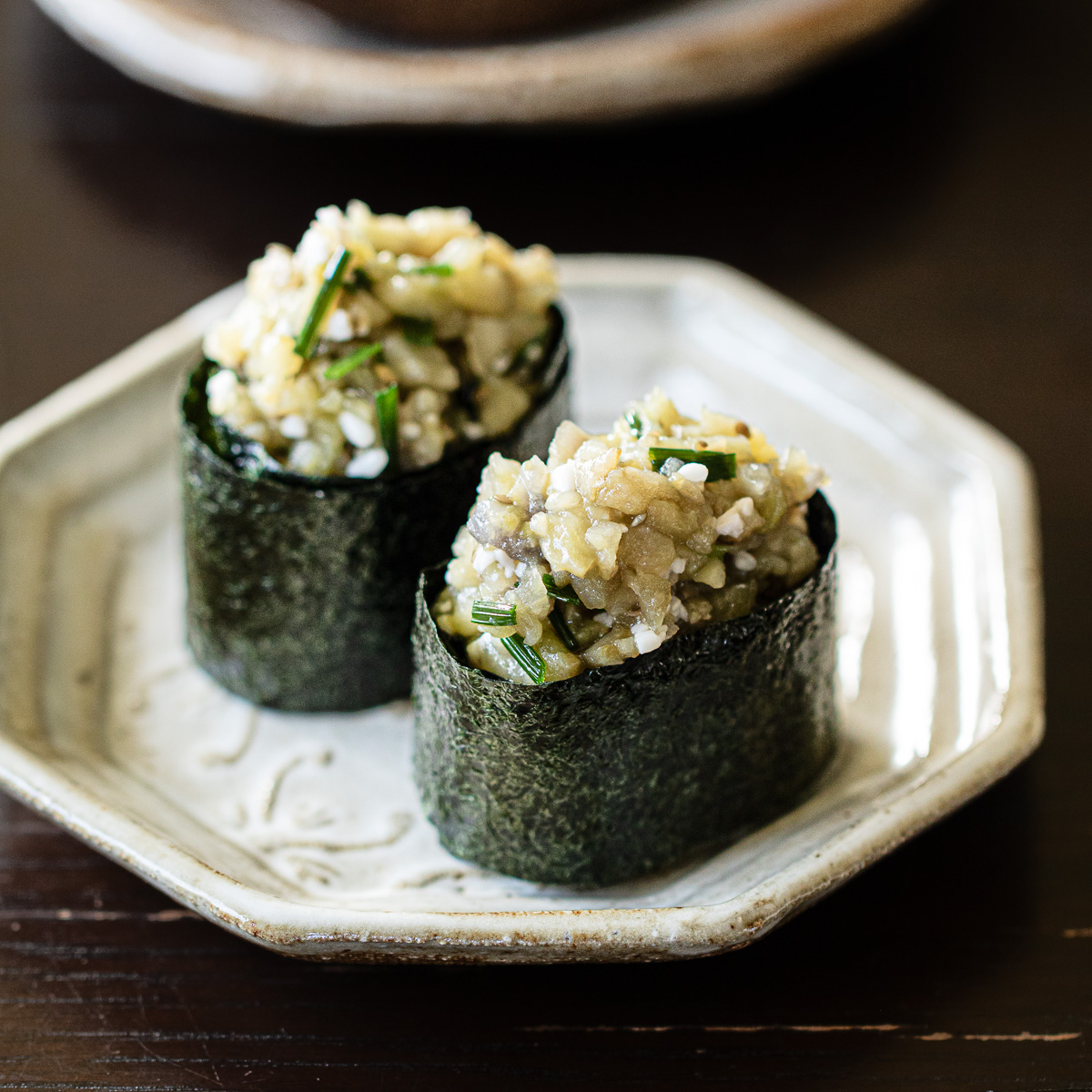
🕊Thank you for spending this time in my kitchen. May your own cooking bring you peace.


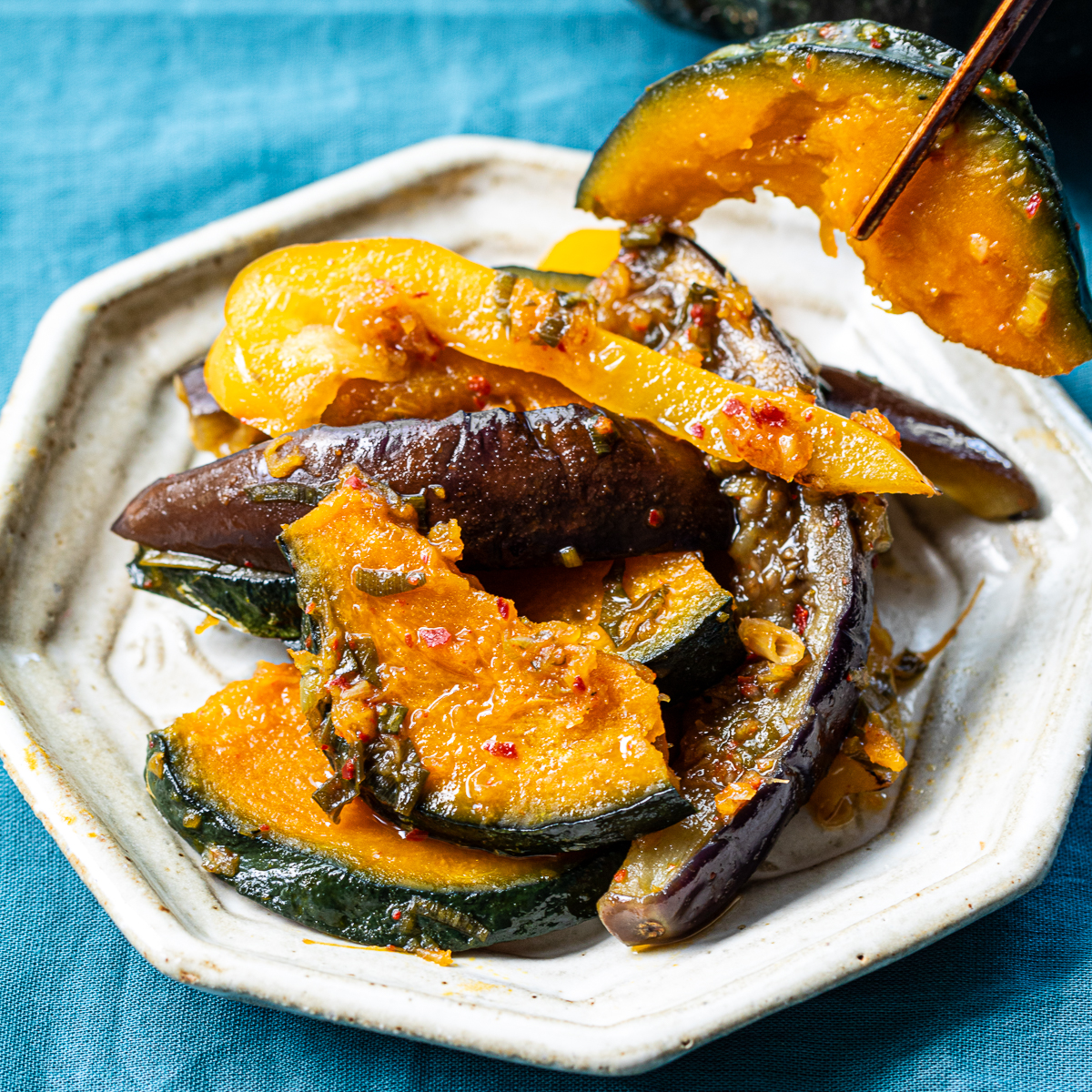

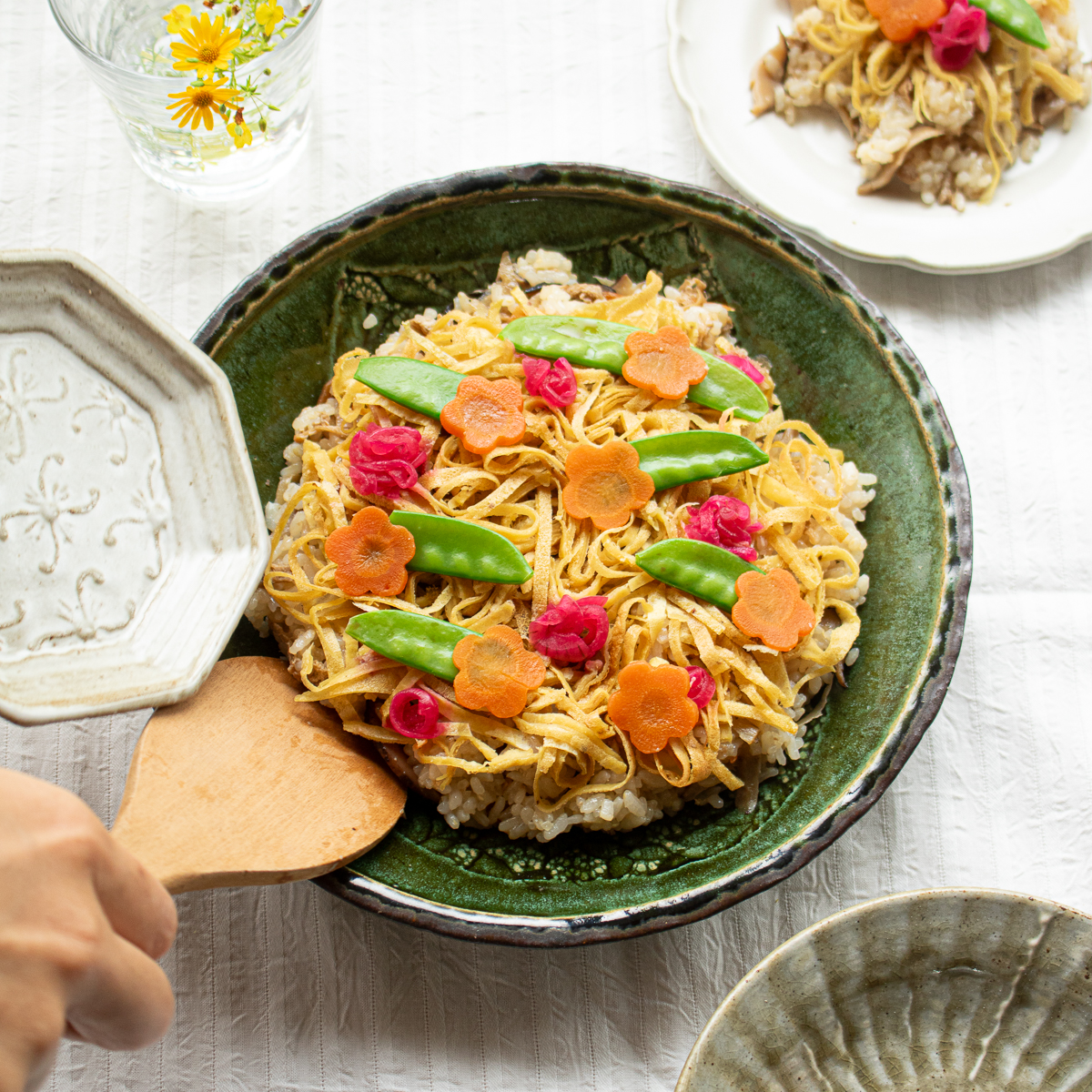
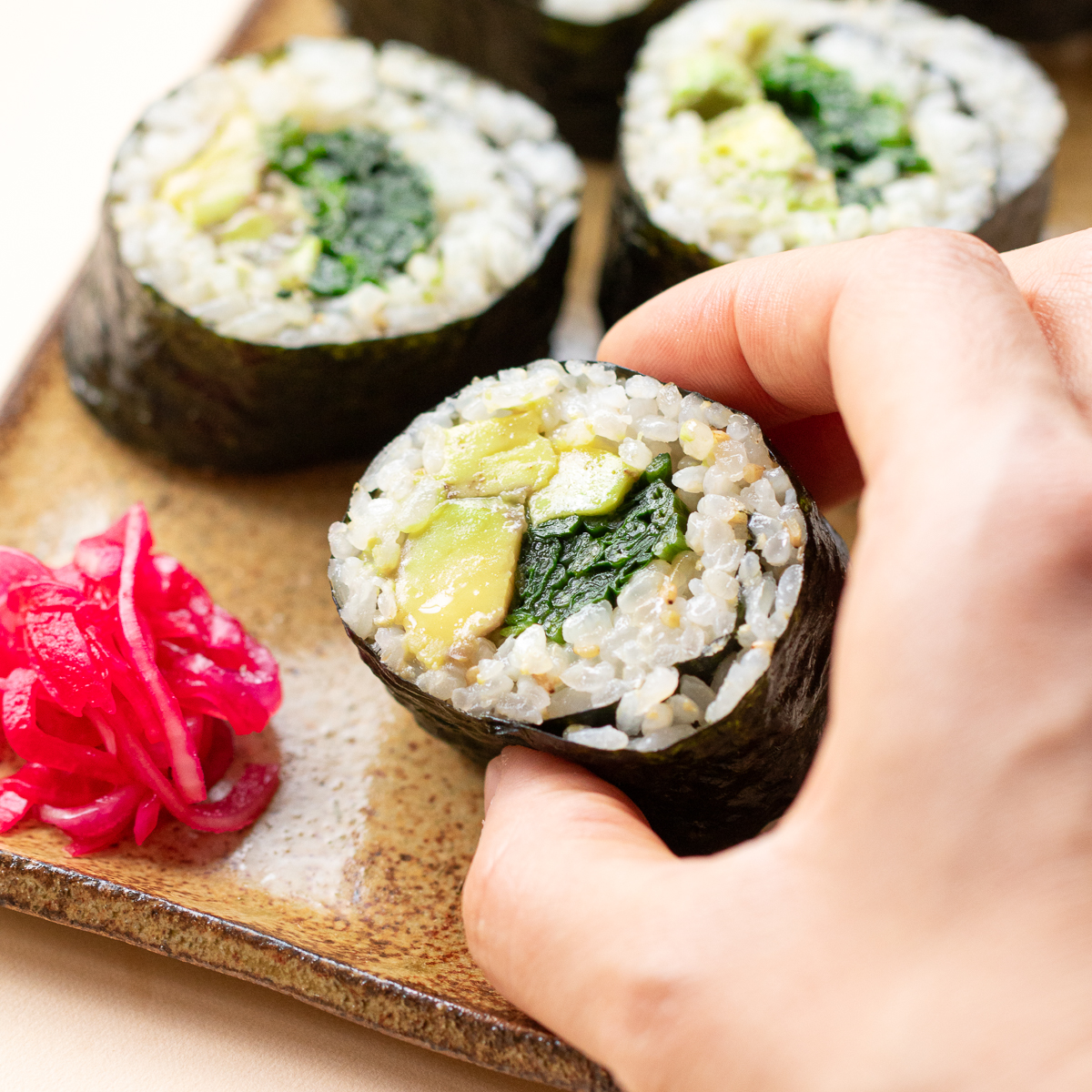


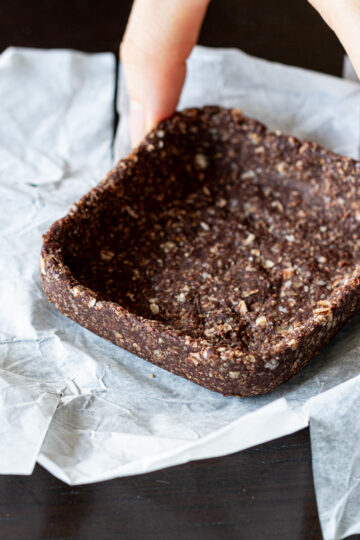
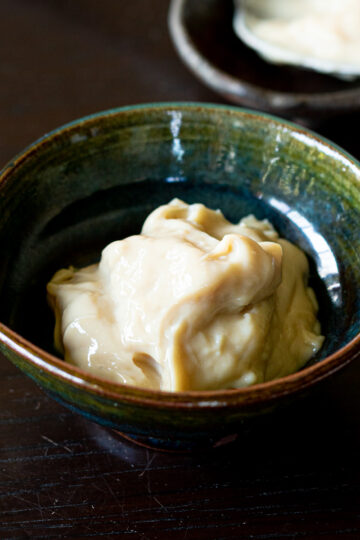
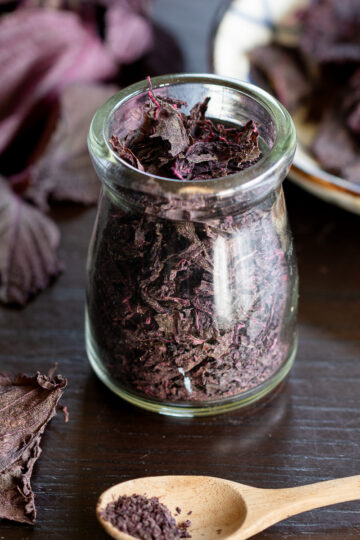
Comments
No Comments